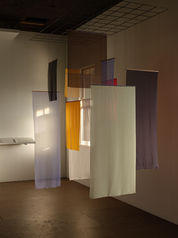A NET WOVEN FROM MY OWN HAIR
24.06.2023 - 08.07.2023
Chez Derrière (exhibition website)
Parnell Project Space, Tāmaki Makaurau Auckland NZ
Curated by Felixe Laing
Accompanying exhibition publication available at Te Tuhi and Haydens
Photography by Sam Hartnett
A net woven from my own hair
Felixe Laing
In her 1986 essay, ‘The Carrier Bag Theory of Fiction’ Ursula K. Le Guin posits that before the tool that forces energy outward (a spear, weapon), early humans made the tool that brings energy home (a bag, vessel).[1] Early humans made textile objects to gather food which offered them practicality and comfort, before developing weapons for hunting. These ‘carrier bags’ quickly extended to other practical and comfortable uses in the ‘home’.
It is from this essay that Jacqueline Stojanović has lifted the title for her exhibition and this accompanying publication, A net woven from my own hair. Stojanović’s weaving practice expands what we might think of as weaving; she is working off the loom. In a A net woven from my own hair she presents a textile installation which approaches the Bauhaus’ architectural principles from a weaver’s sensibilities and draws inspiration from Yugoslav socialist architecture. Here the weaver is playing with the idea of the human structures of time and architecture to construct her reality and reflect on a layered identity.
Many of Stojanović’s images in this publication refer to fractured architecture and textiles in nomadic or transitional states across Serbia and Australia, her home countries. In Naarm Melbourne Stojanović captures moments where she encounters traces of her other home; in a friend’s vintage tote bag, an off-brand Adidas jacket or the tiered base of a table at her local squash club. Her Serbian heritage reveals itself as everyday encounters in her family’s hometown Belgrade and its surrounding areas: the primary coloured vinyl of outdoor lake changing rooms, the idiosyncrasies of Yugoslav socialist apartment blocks, and the flowing ribbons of arches outside suburban homes marking an upcoming marriage.
There is a conflicted nostalgia for Yugoslavia and socialist structures. The Socialist Federation of the Republic of Yugoslavia was dissolved in 1992 and transitioned into a number of emerging democracies and former socialist states.[2] What followed was a continued period of war and political upheaval in the former Yugoslav region.
Each of these former Yugoslav states inherited institutional architecture which embodied their now disowned socialist ideals.[3] Although this architecture is valued by some in local communities, this heritage falls to neglect by the states, continuing as modern archaeological sites.[4] Yugoslav architecture only recently gained international recognition for its unique modernist design and history, most notably in a dedicated 2018 MoMA exhibition.[5]
Yugoslav architecture exists within a contemporary skyline even though Yugoslavia does not. In a city block there is a tangling narrative of built heritage which reflects the layered and multiplicity of a place and an individual’s identity. In this series of photographs, we see threads being drawn between temporary and built structures, including the recurring motif of the moveable structure of the beehive. Other photographed objects are also in liminal states, a table being drawn up the side of a home, towels drying on a line, a rug on a car roof. They are all in transition but equally all at home.
Situated in two places of home Stojanović draws her attention to these moments amongst architectural and textile structures to weave a faceted timeline to place herself in. They articulate a timeline of self, of cultural identity from the perspective of a first generation Australian with Serbian roots and further as a person of adoption.
Weaving and textiles' inextricable relationship to architecture was asserted by the 20th century Bauhaus weaver and writer Anni Albers in her essay, ‘The Pliable Plane: Textiles in Architecture’.[6] She highlighted the organisational and structural nature of weaving and aligned it as an architectural one.[7] At the time Bauhaus upheld a gendered distinction and hierarchy between architecture and weaving. Like Le Guin, Albers reconsiders early human relationships to textiles, recontextualizing them as the original architecture of the nomadic home, one which transitioned into the settled home and the ‘second skin’ or clothing.[8]
This project by design is nomadic; made by Stojanović in Naarm Melbourne, packed alongside these publications into two 20kgs bags and flown with the artist to Aotearoa, then assembled into a final form for the first time at Chez Derriere. The gallery is located at the operational Parnell train station platform, housed in the heritage station building which has had its own transitional life. Built in 1908 and formerly the Newmarket Station building, it was relocated to the newly constructed Parnell Station in 2016. Currently, it houses Te Tuhi’s Studios and Parnell Project Space (currently under the name Chez Derriere).[9] The gallery’s burnt and rusted pressed metal ceiling has a fractured grid like pattern, a particular point of interest for the artist.
The installation’s suspended textile panels with their varying transparency layer upon each other, their forms shifting as a viewer negotiates the gallery space. Instead of producing a textile, made from organising threads on a grid – Stojanović layers textiles within a grid structure in an architectural manner. Here, weaving considers human structures, be those physical architectural structures and spaces or cultural structures and time. The multiplicity and shapeshifting qualities of the installation embody the artist’s reflections on migration, home and belonging. A net woven from my own hair can be positioned as a temporary structure, and a layered, shifting self and home.
[1] Le Guin, The Carrier Bag Theory of Fiction, 32.
[2] Jovanovic Weiss, Srdjan and Armin Linke, “Socialist architecture the reappearing act”
[3] Jovanovic Weiss and Linke, “Socialist architecture the reappearing act”
[4] Sekularac, “Former Yugoslavia's brutalist beauty – a photo essay.”
[5] Sekularac, “Former Yugoslavia's brutalist beauty – a photo essay.”
[6] Albers, “The Pliable Plane; Textiles in Architecture,” 36.
[7] Albers, 36.
[8] Albers, 36.
[9] Te Tuhi, “Te Tuhi studios at parnell station.”


















